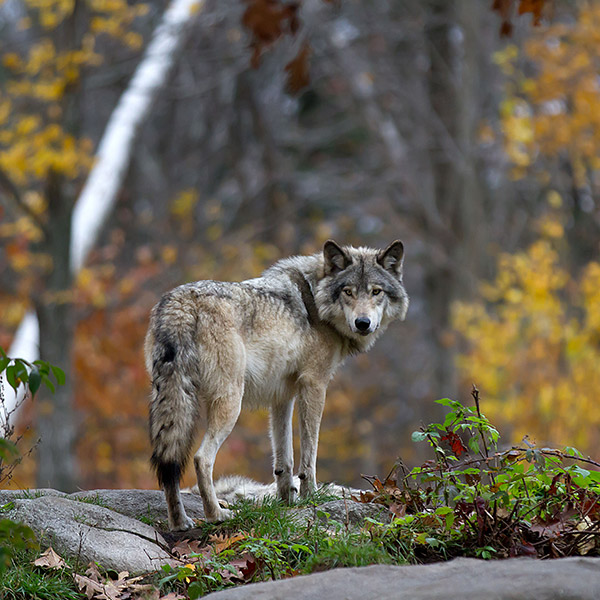Gray Wolf
Canis lupus

Animal Ambassadors
Rogue (F) & Takelma (M)
Shadow
Gray wolves: Despite their name, gray wolves can come in many shades of color, including white, cinnamon, black, brown, taupe, or gray. All gray wolves, however, have a thick undercoat of gray fur. Wolves live in family units called packs with anywhere from 2 to 40 individuals! People often talk about “alpha wolves,” but this is actually based on a misconception. Wolves don’t have a dominance hierarchy with clear leaders and subordinates; they’re usually just families! Pups can remain with their parents for several years, helping care for younger litters until they break away and disperse to have pups of their own. Although they will eat a wide variety of prey, wolves typically specialize in hunting hoofed prey such as deer, elk, moose, or bison. In order to provide their packs with enough space to find adequate food, wolves must be highly territorial. Although territorial fights are one of the highest causes of mortality for wolves, they avoid many conflicts by scent-marking and howling to warn other wolves away.
These canines are extremely adaptable and were historically found throughout almost all of North America and most of Eurasia. Unfortunately, wolves were extirpated from many regions, including most of the lower 48 states. They were aggressively hunted, trapped, and poisoned, often by governmental agencies. This was largely due to the negative myths and misconceptions surrounding wolves. Luckily, their eventual listing under the Endangered Species Act gave protection to the few wolves left in the U.S. and allowed for increased scientific research, reintroduction and management programs, and educational programs. Gray wolves were reintroduced into Yellowstone National Park in 1995. Scientists have observed many surprising changes in the ecosystem since wolves have returned. Wolves provide food for scavengers such as ravens, eagles, bears, foxes, or wolverines. They have caused coyote populations to decline, which has in turn increased rodent and songbird populations. Additionally, the presence of wolves encourages large ungulates such as elk to stay on the move, allowing for regrowth of riparian willows, aspens, and cottonwoods. As more and more research is published, the vital role of wolves and other apex predators becomes even more apparent. Since the reintroduction of gray wolves, these predators have slowly been returning to parts of their historic range. There are now several wolf packs found in Oregon!
Wolf-hybrids: A wolf-hybrid is an animal that is part domestic dog and part wolf; this mix is typically achieved by breeding existing wolf-hybrids with other wolf-hybrids, rather than breeding a pure wolf with a pure dog. Because the two species are so closely related, it isn’t possible to accurately describe the hybrids by percentages. Instead, individuals are typically described as low-, mid-, or high-content mixes depending on their morphological and behavioral traits. It is incredibly difficult to predict what traits a wolf-hybrid will inherit, but they typically have small ears, golden eyes, narrow shoulders, flat feet, cheek ruffs, pointed muzzles, and fluffy, low-set tails. However, purely domestic dogs can also possess many of these traits as well. Additionally, hybrids tend to be much more skittish, fearful, and behaviorally inflexible than domestic dogs. Even incredibly well-socialized animals may never be leash-trained, be capable of safely leaving the house, or be comfortable around more than a handful of people. This can make them incredibly difficult to train, house, and care for.
Large game, small and medium mammals, birds, carrion, small amounts of fruit and vegetable matter
Historically across most of North America and Eurasia; extirpated in many regions
7-16 years / 15-18 years
Highly adaptable; coniferous and deciduous forests, open plains, tundras, semi-arid regions
80-100 lbs
